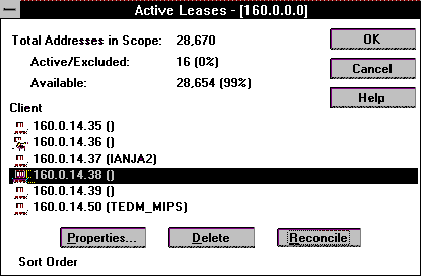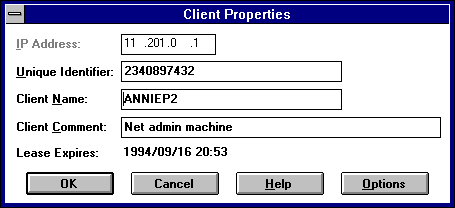
The lease for the IP address assigned by a DHCP server has an expiration date, which the client must renew if it is going to continue to use that address. You can view the lease duration and other information for specific DHCP clients, and then you can add options and change settings for reserved DHCP clients.
Information about active leases in the currently selected scope is shown in the Active Leases dialog box. In addition to information on individual leases and reservations, the Active Leases dialog box also shows the total number of addresses in the scope, the number and percentage of addresses that are currently unavailable because they are active or excluded, and the number and percentage of addresses that are currently available.
Because the count of active leases and excluded addresses is an aggregate, it cannot tell you want you want to know about only the active leases. The Active/Excluded count when a scope is deactivated reflects only excluded addresses. To determine the number of active leases and reservations, compare the Active/Excluded count before and after the scope is activated.
Leases are retained in the DHCP server database approximately one day after expiration. This grace period protects a client's lease in case of client and server are in different time zones, the two computers' clocks are not synchronized, or the client computer was off the network when the lease expired. These expired leases are included in the aggregate Active/Excluded count, as well as in the list of active clients in the Active Leases dialog box. They are distinguished by a dimmed icon.

If you want to view only clients that use reserved IP addresses, check the Show Reservations Only box.

Note You can only edit the name, unique ID, and comment, or choose the Options button in the Client Properties dialog box for clients with reserved IP addresses.
For information about the Options button in this dialog box, see "Defining Options for Reservations" earlier in this chapter.
You can delete the lease of any DHCP client in the scope. The main reason for doing so is to remove a lease that conflicts with an IP address exclusion or a client reservation that you want to add. Deleting a lease has the same effect as if the client's lease expired—the next time that client computer starts, it must enter the initialization state and obtain new TCP/IP configuration information from a DHCP server. There is nothing, however, to prevent the client from obtaining a new lease for the same IP address; you must make the address unavailable before the client requests another lease.
Important
Delete only entries for clients that are no longer using the assigned DHCP lease or that are to be moved immediately to a new address. Deleting an active client could result in duplicate IP addresses on the network, because deleted addresses will be assigned to new active clients.
After you delete a client's lease and then set a reservation or exclusion, you should always type the ipconfig /release command at the command prompt for a DHCP client computer to force the client to free its IP address.
From the Command Prompt on the client computer, use the ipconfig/release command.
From the Command Prompt on the client computer, use the ipconfig/renew command.